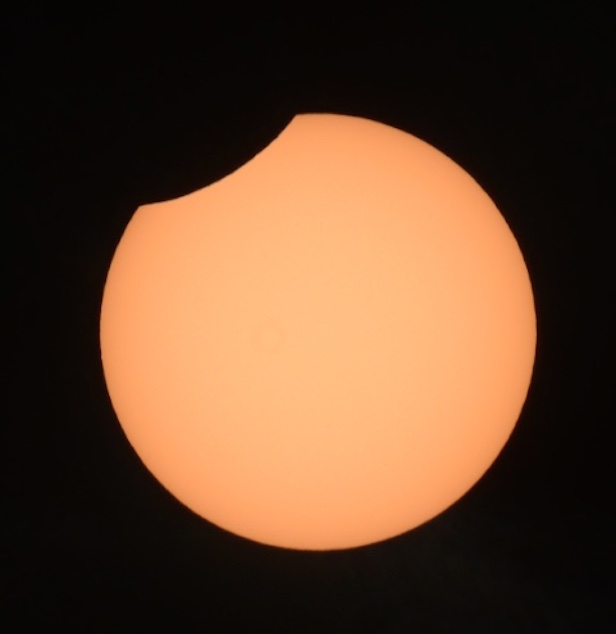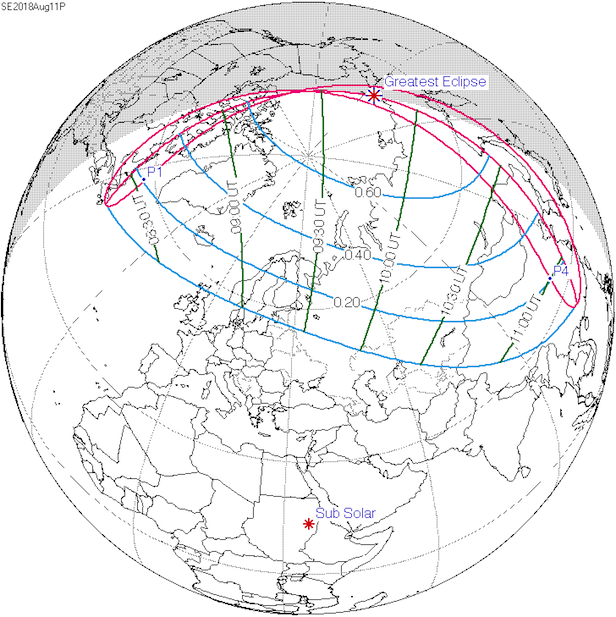Astronomers watch partial solar eclipse across Europe and Asia
The event of 11 August 2018, was viewed by dedicated eclipse observers and others from the northern part of the Earth

The photographer had a view of 4 per cent coverage of the Sun’s diameter by the Moon in clear sky. Image credit: Jay Pasachoff
The partial solar eclipse of 11 August 2018, was viewed by dedicated eclipse observers and others from the northern part of the Earth. Solar eclipses occurred at opposite ends of the Earth this summer. Both were merely partial solar eclipses as seen from the Earth’s surface, not as dramatic as last summer’s total solar eclipse, whose path of totality crossed the United States.
Prof. Jay Pasachoff, Chair of the International Astronomical Union’s Working Group on Eclipses, viewed both, though weather forecasts led him to stay in Stockholm, Sweden, on 11 August, where he had a view of 4 per cent coverage of the Sun’s diameter by the Moon in clear sky. A group led by Tora Greve of Malmö, Sweden, went ahead with the original arrangements above the Arctic Circle in northern Sweden, where 25 per cent of the solar disc was covered at maximum, and succeeded by driving from Kiruna northeast to Abisko, near the Norwegian border, in seeing the beginning of the eclipse before the forecast clouds and rain came. Robert Lucas of Sydney, Australia, gambled on the larger coverage near Kiruna, and won, while Pasachoff played it safe in Stockholm.
Xavier Jubier of Paris, France, went to Yakutsk, northeastern Siberia, Russia, where he had 57 per cent of the Sun’s area and 65 per cent of its diameter covered. He plans to return to Yakutsk this coming winter for the 6 January 2019, partial solar eclipse with an obscuration of 56 per cent of the area and a magnitude of 0.66 of the solar diameter, all this with temperatures likely below -50°C (-68°F).
Passengers on a cruise ship, the Eclipse, north of Scotland sailing towards Ireland, missed seeing the eclipse because of clouds. Bill Kramer from Jamaica, keeper of a list of “eclipse chasers” and their duration in the Moon’s shadow and number seen, was one of those passengers.
At Zhou Guanhuai’s location in Hefei City in eastern China, the eclipse just started 25 minutes before sunset locally; there were some clouds in the lower sky, most of the eclipse process was obscured by the clouds. However, the Sun just came out for three to four minutes before so the eclipse was photographed near the horizon.
During this summer’s partial solar eclipses, the Moon never entirely covered the everyday disk of the Sun, so the eclipse observers used special solar filters throughout to cover their eyes and their camera lenses.
The International Astronomical Union (IAU)’s Working Group on Solar Eclipses, in existence in some form since the IAU’s formation 99 years ago, includes members from the U.S., Canada, England, Slovakia, Russia, Japan, China, India, and France. Pasachoff will report on the history of the Working Group, and its predecessor Commissions and Subcommissions, at the Centennial Symposium to be held at the IAU’s triennial General Assembly in Vienna, Austria, in late August. The Working Group is joint between the “Sun and Heliosphere” Division and the “Education, Outreach, and Heritage” Division.
After 2017’s major total solar eclipse, 2018 is a year without a total or annular (“ring”) eclipse, so there was a Solar Eclipse Conference. It was held in Genk, Belgium, during 3 to 6 August and various professional and amateur astronomers discussed scientific and non-scientific eclipse-related matters.
The following solar eclipse to the ones discussed above will be a partial eclipse visible in eastern Asia – including Siberian Russia, Japan, eastern China, South Korea, and North Korea, as well as southwestern Alaska on January 6, 2019. (42 per cent coverage in Tokyo and 20 per cent coverage in Shanghai.) A total solar eclipse will cross the Pacific in the South American winter on 2 July 2019, reaching Chile only 13 degrees above the horizon and then extending until sunset near the Argentinian Atlantic Coast. An annular eclipse extending from Saudi Arabia and Oman through southern India and Sri Lanka to southern Malaysia and Singapore and on to Guam in mid-Pacific will occur on December 26, 2019. Following will be another annular eclipse with a path of annularity from Africa through southern Asia to the Pacific on 20 June 2020. A total solar eclipse peaking over Argentina, and with its path of totality crossing Chile and Argentina, will occur in the South American summer on 14 December 2020.
For American viewers, the northeastern states will see partial phases of the annular solar eclipse of 10 June 2021. All of Europe and the Middle East will see the partial eclipse of 25 October 2022. Almost all of North America and South America will see partial phases of the annular solar eclipse of 14 October 2023, whose path of annularity passes from the United States into northern South America. The path of totality of the 8 April 2024, total solar eclipse crosses Mexico and the United States from Texas to Maine, and on into easternmost Canada, with partial phases through all but northernmost North America and all of Central America. Total eclipses of the Sun, in which the sky darkens during daylight, are much more dramatic than total eclipses of the Moon, the next of which will be visible in the United States on 20/21 January 2019.
Pasachoff is a veteran solar-eclipse observer, having started as a first-year student at Harvard. He has observed at 34 total solar eclipses and a total so far of 69 solar eclipses of all types.
Keep up to date with the latest news in All About Space – available every month for just £4.99. Alternatively you can subscribe here for a fraction of the price!





